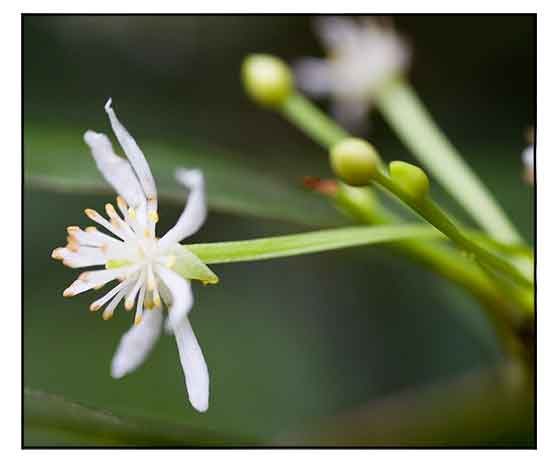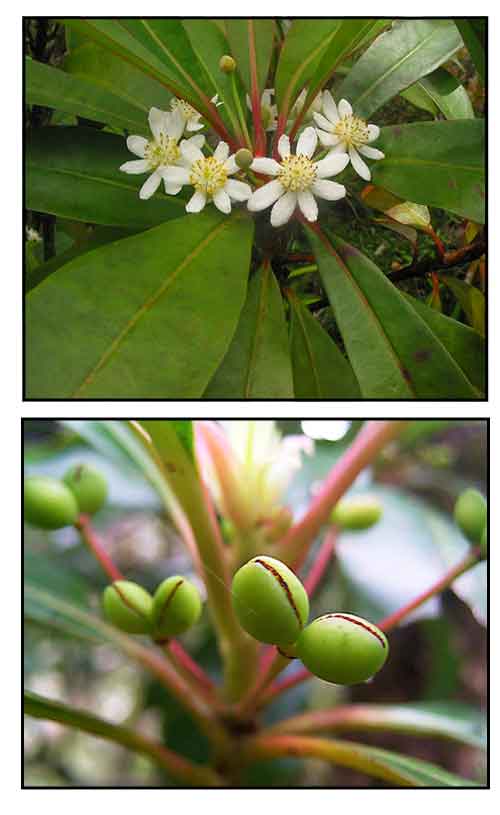 Gen info Gen info
- Tasmannia is a genus of about 36 species of flowering plants in the family Winteraceae, native to Australia and New Guinea, with one species, Tasmannia piperita also found in parts of Southeast Asia. (2)
-
Tasmaninia piperita is a species of shrubs or treelets in Winter's bark family Winteraceae, native to Borneo, the Philippines, Sulawesi, Flores and New Guinea. It is the most widespread species of Tasmannia, and the only one occurring outside of Australia, and which is not found in Australia. (3)
- Etymology: The genus name Tasmannia honors the Dutch explorer Abel Tasman.
- The taxonomic status and relationship between Tasmannia and Drimys has been a subject of controversy for many years. A 2004 paper by Andrew Doust and Andrew Dinnan confirmed the two genera do not form a monophyletic group, although sharing distinctive similarities in the flowers. (3)
Botany
• Drimys piperita Hook. f. (Winteraceae), locally known as sapal in Mt. Province, is a shrub, sometimes scrambling or epiphytic, or treelet, that grows from 0.1 – 13.0 m high. Fruits are obovoid to ellipsoid, up to 15 x 8 x 7.5 mm, black and nitidous to orange-brown and dull. Leaves are scattered to pseudoverticillate, blades are elliptic or obovate to lanceolate (Vink, 1970). (8)
• The flower is most variable. It may have as many as 15 petals or as few as none, as many as 109 stamens or as few as 7, and as many as 15 carpels or as few as one. (2)
 Distribution Distribution
- Native to the Philippines. (1)
- Mostly in montane forests, 840-2700m.
- This plant is abundant on exposed ridges and peaks and in the mossy forests of the higher mountains of Luzon, Mindoro, Leyte, Negros, Panay, and Mindanao.
- Also native to Borneo, Lesser Sunda Is., Maluku, New Guinea, Solomon Is., Sulawesi. (1)
Constituents
- Secondary metabolite profiles of fresh methanolic extract revealed presence of flavonoids, glycosylated flavonoids, polyphenols, sesquiterpene lactones, glycerides, phosphocholines, and pigments. (see study below) (4)
- Crude ethanol extract of leaves yielded saponins, flavonoids, cardenolides, and polyphenolic compounds. (see study below) (8)
- Study of stem bark for antioxidant activity showed the best bark:ethanol ratio was obtained at 1:4 (b/v) ration with 9.54% extract yield, 289.57 mg GAE/g total phenolic content, 185.47 mg QE/g total flavonoids.
(see study below) (10)
Properties
- Studies have suggested fungicidal, biopesticidal, antispasmodic, antidiarrheal, antioxidant, antibacterial properties.
Parts used
Leaves, bark, fruits.
Uses
Edibility
- In Ifugao, herbal tea is made by boiling fresh or dried young leaves of sapal (Drimys piperita).
Folkloric
- In the Mt. Province, dried fruits and decoction of leaves used to treat diarrhea and stomach disorders. Fresh young leaves are boiled in water and drunk as tea. Leaves used to treat cough and colds. Dried fruits are chewed or ground due to its bitter and pungent taste, or simply swallowed whole. (8)
- The Kankanaeys of Kibungan, Benguet Province,
eat raw and dried fruits for stomach ache; decoction of fruit drunk to treat loose bowel movements. (13)
- In India, leaves used for treatment of malaria. (5)
Others
- Veterinary: Preliminary study has shown sapal fruit can eliminate diarrhea problems in piglets. (8)
Studies
• Natural Fungicide / Leaves: In a study of seven species of indigenous plants collected in Mindanao as potential sources of fungicide, Tasmannia piperita showed highest amount of phenolic and flavonoid content. Secondary metabolite profiles of fresh methanolic extract revealed presence of flavonoids, glycosylated flavonoids, polyphenols, sesquiterpene lactones, glycerides, phosphocholines, and pigments. Molecular docking study showed 3-genistein-8-C-glucoside (7) and rhoifolin (8) with the highest docking score against 2NAR while cyranoside (6), trihydroxyisoflavone (10), and apigenin-7-O-glucuronide (12) against fungal phytopathogen Phytophthora infestans (PDB ID: 3ZRG). Compound 8, rhoifolin, showed highest docking study against P. infestans 5L7S. Results provide scientific bases for use of methanolic extract for development of a natural fungicide from T. piperita. (4) Screening of ten potential indigenous plants from Mindanao, showed leaves of T. piperita are effective when used as organic pesticide. (6) Study showed leaf extract in 1:100,000 dilution was most effective in inhibiting mycelial growth of P. infestans on 3rd, and 6y-9th day after treatment. (7)
• Biopesticide Emulsion: Invention relates to a pesticidal formulation and preparation that utilizes a plant extract from Tasmannia piperita comprised with effective amount of the plant extract, oil, emulsifier, and sufficient amount of water. (5)
• Antispasmodic / Leaves: Study of leaves using charcoal tracing method isolated 15-nonacosanol and bis(tridecyl)phthalate as anti-spasmodic constituents. 15-Nonacosanol and imodium, a commercially available antidiarrhea) showed almost 100% inhibition at dosages of 2.00 mg and 0.20 mg/20 g mouse, respectively, while bis(tridecyl)phthalate, at dosage of 0.80 mg/20g mouse exhibited 88% anti-spasmodic activity. Results validate the use of sapal leaves for the symptomatic relief of diarrhea. (8)
• Synthesis of Anti-Diarrheal Agents from Leaves: Study reports on the isolated of two major anti-diarrheal agents from Sapal leaves: antidiarrheal agent 1 and dicyclohexyl carbodiimide (DCC)mediated esterification of phthalic anhydrate to afford 2. Study of SAR (Structure Activity Relationship) of the compounds synthesized several analogs: 10-Nonadecanol (C19), 16-Hentriacontanol (C31), 7-Tridecanol (C13) and 13-Pentacosanol (C25) for the alcohol compound and Di-undecyl Phthalate (C-11), Dipentyl Phthalate (C-5), C-14 and C-15 diester for the diester compound. (9)
• Antioxidant / Stem Bark: Study evaluated the antioxidant activity of Akway (Drymis piperita) stem bark ethanol extract. The best Akway bark:ethanol ratio was obtained at 1:4 (b/v) ration with 9.54% extract yield, 289.57 mg GAE/g total phenolic content, 185.47 mg QE/g total flavonoids. The stem bark extract showed potential as a source of antioxidants as indicated by high antioxidant activity with DPPH free radical scavenging and ferric reducing activity of 50% (IC50) at extract concentrations of 16.59 and 60.93 µg/mL respectively, and carotene bleaching inhibition activity of 85.76%. (10)
• Antimicrobial / Leaves: Study of methanol and ethanol extracts of leaves of Drymis piperita for antibacterial activity against Escherichia coli and Staphylococcus aureus using disc diffusion method showed zones of inhibition of 16 -19 and 14 -16 mm respectively, compared to oxacillin (1 ug) and chloramphenicol (30 µg) with 32 and 26 mm respectively. Phytochemical screening yielded alkaloids, carbohydrates, reducing sugar, phytosterols, phenolics, flavonoids, and proteins. (11)
• Herbal Teas / Leaves: Herbal tea brewed from S. glabra and D. piperita at 1:1 and 2:1 ratios have stronger aroma and flavor intensity with moderate bitterness and were moderately accepted; herbal tea at 1:2 ration had strong bitterness and was slightly accepted by regular and non-tea drinkers. (11)
• Antibacterial / Essential Oil / Bark: Study evaluated the antibacterial activities of essential oil isolated from akway bark using agar well diffusion method. Results showed antibacterial activity that increased with increasing concentrations. Minimum inhibition concentrations against Escherichia coli, Bacillus cereus, Pseudomonas aeruginosa, and Staphylococcus aureus were 0.28 - 0.56%. The pH and sodium chloride contents did not significantly influence antibacterial activity of bark essential oil. (12)
Availability
Wild-crafted.
|

![]()




 Distribution
Distribution